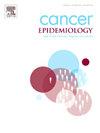成年期身体肥胖的轨迹与卵巢癌的风险
IF 2.3
3区 医学
Q3 ONCOLOGY
引用次数: 0
摘要
虽然老年期身体过度肥胖与卵巢癌有关,但随着时间的推移,身体肥胖变化的影响尚不清楚。这项研究调查了成年期身体质量指数(BMI)轨迹与卵巢癌之间的关系,BMI是身体肥胖的代表。方法在一项基于人群的病例对照研究(440例,820例对照)中,我们采用基于群体的轨迹方法来确定20-70岁之间的BMI轨迹。使用无条件逻辑回归,我们估计校正比值比(aOR)和95 %置信区间(95 % CI)估计轨迹与卵巢癌之间的关联。我们确定了三种不同的BMI轨迹:正常-稳定轨迹,正常-超重轨迹和超重-肥胖轨迹,分别包括63.2% %,31.0% %和6. %的人群。多变量aOR提示,成年期体重正常的参与者在成年期超重与成年期保持正常体重的参与者相比,患卵巢癌的风险没有差异(aOR(95 %CI): 0.89(0.69-1.16))。在超重到肥胖的轨迹中,aOR(95 %CI)为1.45(0.87-2.43),因此与保持正常体重的人相比,卵巢癌风险增加的方向。结论我们的研究结果强调需要进一步的研究来阐明一生中身体肥胖在卵巢癌病因中的作用。本文章由计算机程序翻译,如有差异,请以英文原文为准。
Trajectories of body fatness in adulthood and the risk of ovarian cancer
Background
While excess body fatness in older adulthood has been linked to ovarian cancer, the influence of changes in body fatness over time is unclear. This study examined the association between adulthood trajectories of body mass index (BMI), a proxy for body fatness, and ovarian cancer.
Methods
In a population-based case-control study (440 cases, 820 controls), we used a group-based trajectory approach to identify BMI trajectories from age 20–70. Using unconditional logistic regression, we estimated adjusted odds ratios (aOR) and 95 % confidence intervals (95 % CI) for the associations between the estimated trajectories and ovarian cancer.
Results
We identified three distinct BMI trajectories: a normal-stable trajectory, a normal-to-overweight trajectory and an overweight-to-obese trajectory, which included 63.2 %, 31.0 % and 6.8 % of the population, respectively. Multivariable aORs suggested that participants with normal weight at the onset of adulthood who became overweight over their adulthood time did not differ in their risk of ovarian cancer compared to those who maintained a normal weight throughout adulthood (aOR (95 %CI): 0.89 (0.69–1.16)). Among those in the overweight-to-obese trajectory, the aOR (95 %CI) was 1.45 (0.87–2.43), and thus in the direction of an increased ovarian cancer risk compared to those who maintained a normal weight.
Conclusion
Our findings underscore the need for further research to clarify the role of body fatness across the lifetime in the etiology of ovarian cancer.
求助全文
通过发布文献求助,成功后即可免费获取论文全文。
去求助
来源期刊

Cancer Epidemiology
医学-肿瘤学
CiteScore
4.50
自引率
3.80%
发文量
200
审稿时长
39 days
期刊介绍:
Cancer Epidemiology is dedicated to increasing understanding about cancer causes, prevention and control. The scope of the journal embraces all aspects of cancer epidemiology including:
• Descriptive epidemiology
• Studies of risk factors for disease initiation, development and prognosis
• Screening and early detection
• Prevention and control
• Methodological issues
The journal publishes original research articles (full length and short reports), systematic reviews and meta-analyses, editorials, commentaries and letters to the editor commenting on previously published research.
 求助内容:
求助内容: 应助结果提醒方式:
应助结果提醒方式:


